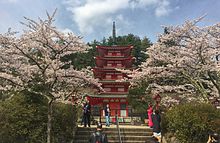Arakurayama Sengen Park
| Arakurayama Sengen Park | |
|---|---|
 Chūrei-tō with Mt. Fuji | |
 | |
| Location | Fujiyoshida, Yamanashi Prefecture |
| Coordinates | 35°30′4.3″N 138°48′5.0″E / 35.501194°N 138.801389°E |
| Created | 1959 |
Arakurayama Sengen Park (新倉山浅間公園, Arakurayama-Sengen-Kōen) is a block park located at 3353 Arakura, Fujiyoshida, Yamanashi Prefecture, Japan. Installed in October 1959.[1] Located on the hillside of Mount Arakura (Template:Lang-ja), it covers an area of about 4.3 hectares.
Sangoku Daiichisan Arakura Fuji Sengen Shrine (Template:Lang-ja) is enshrined, and Mount Arakura is a sacred area. There are about 650 cherry blossoms (Prunus × yedoensis)[2] and a memorial tower for the war dead in the park.
Landscape
It is a park with a panoramic view of Fujiyoshida city and Mount Fuji, and is famous for its five-storied pagoda (a pagoda for the war dead (忠霊塔, Chūrei-tō), not a pagoda), cherry blossoms, and Mount Fuji.[1] It has been selected as one of the "100 Scenes with Mount Fuji" announced by the Japanese Ministry of the Environment. It has also been published in Lufthansa's in-flight magazine and textbooks used in Thai compulsory education courses,[3] and became the cover of the 4th revised edition of "Michelin Green Guide Japan", has received two ratings.[4] Fujisan Keizai Shimbun considers that the number of foreign visitors to temples and shrines around Mount Fuji has increased due to this and the influence of Mount Fuji's registration as a World Heritage Site.[5]
By appealing to a Thai tourism company in 2011, Yamanashi Prefecture is particularly popular and well-known among Thais as "a place where you can see Kyoto and Fuji at the same time".[6] The shooting and viewing point is on private land next to the park,[3] and there is a cliff about 5 meters high between it and the park.[3] As the number of tourists, including foreigners, has increased and many tourists have come to the masonry and slopes,[7] Fujiyoshida City has taken pictures and views from the beginning of September 2015 to December of the same year. Construction was started with the area off limits, and fences were installed.[1]
In April 2016, the Arakurayama Sengen Park Sakura Festival was held for the first time. In order to accommodate foreign tourists, English, Thai, and Chinese language pointing conversation cards were distributed to store owners.[8] Furthermore, since there is a colony of irises when climbing Mount Arakura from the Chūrei-tō for about 15 minutes, the "Ayame Matsuri" (あやめ祭り) is also held around June in the park.[9]
Since the cherry blossoms (Prunus × yedoensis) planted in the park have become old trees and the tree vigor is declining. Since 2018, the city, which manages the trees, has been carrying out cherry tree vigor restoration work by a tree doctor who belongs to the cooperation of the Flower Association of Japan.[10] In 2019, in addition to soliciting donations through crowdfunding, Fuji Kyuko donated 1 million yen.[11]
It was closed from 3 April 2020 to prevent the spread of COVID-19,[12] but was reopened on 1 June 2020, except for the observation deck.[13]
Facility list

- Sakuya-hime Stairs (Template:Lang-ja)
- Parking
- 87 ordinary cars.[1]
- Lee Yangji's literary monument
- Unveiled on 22 May 2016. Due to the relationship that Lee Yangji grew up in Fujiyoshida.[15]
- Memorial Pagoda for the War Dead (忠霊塔 (Chūrei-tō), Location: 3360-1, Chureito Pagoda, Arakura, Fujiyoshida City, Yamanashi Prefecture)
Traffic access
- 10 minutes walk from Shimoyoshida Station on the Fujikyuko Line.[14]
- 10 minutes by car from the Chūō Expressway Fujiyoshida Nishikatsura Smart IC,[14] 10 minutes on foot from the Shimoyoshida bus stop.[17]
References
- ^ a b c d e "新倉山浅間公園". 富士吉田市 (in Japanese). Retrieved 27 June 2016.
- ^ "新倉山浅間公園". フジヤマNAVI (in Japanese). Retrieved 28 August 2015.
- ^ a b c d "山梨)絶景人気の新倉山浅間公園 市、転落防止の整備へ". 朝日新聞デジタル (in Japanese). 13 May 2015. Retrieved 5 January 2020.
- ^ "「新倉山浅間公園からの富士山」、ミシュラン旅行ガイドの表紙に". 富士山経済新聞 (in Japanese). 25 June 2015. Retrieved 5 January 2020.
- ^ "富士山周辺の寺社を訪れる外国人増加 英語で書かれた絵馬も". 富士山経済新聞 (in Japanese). 4 September 2015. Retrieved 5 January 2020.
- ^ "富士山:「京都」と同時に見たい…タイ観光客に人気の場所". 毎日新聞 (in Japanese). 9 May 2015. Archived from the original on 2 July 2015. Retrieved 10 January 2020.
- ^ "新倉山浅間公園に展望デッキ設置 利用者の安全・利便性確保へ". 富士山経済新聞 (in Japanese). 22 December 2015. Retrieved 5 January 2020.
- ^ "富士山・桜・五重塔を望む「新倉山浅間公園 桜まつり」初開催へ". 富士山経済新聞 (in Japanese). 5 April 2016. Retrieved 5 January 2020.
- ^ "新倉山浅間公園で「あやめ祭り」". 富士山経済新聞 (in Japanese). 27 May 2016. Retrieved 5 January 2020.
- ^ "桜の樹勢回復へ 富士急行が寄付 富士吉田市へ100万円」". 『日本経済新聞』朝刊(東京経済面) (in Japanese). 26 December 2019. Retrieved 5 January 2020.
- ^ "「桜の樹勢回復へ 富士急行が寄付 富士吉田市へ100万円」". 『日本経済新聞』朝刊(東京経済面) (in Japanese). 26 December 2019. Retrieved 5 January 2020.
- ^ "新型コロナウイルス感染症拡大を抑えるため、新倉山浅間公園を終日閉鎖します". 富士吉田市 (in Japanese). Retrieved 11 April 2020.
- ^ "緊急事態宣言の解除に伴い、新倉山浅間公園を開放します。(※展望デッキは閉鎖継続中)". 富士吉田市 (in Japanese). Retrieved 9 July 2020.
- ^ a b c "新倉山浅間公園(あらくらやませんげんこうえん)". 富士の国やまなし観光ネット (in Japanese). Retrieved 28 August 2015.
- ^ "李良枝さんの文学碑除幕". 『さんにちEye 山梨日日新聞電子版』 (in Japanese). 23 May 2016. Archived from the original on 5 August 2016. Retrieved 10 January 2020.
- ^ "<桜の名所>新倉山浅間公園". 富士山NET (in Japanese). Retrieved 28 August 2015.
- ^ "訪日外国人は高速バスでどこへ行く 増便しても予約困難な路線、なぜそこが人気なのか" (in Japanese). メディア・ヴァーグ. 16 June 2018. Retrieved 13 September 2020.
